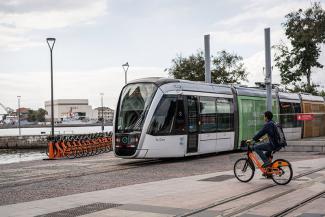KfW
18 million fewer car journeys

The first line in the “VLT Carioca” tram network, as it is known, started operation in June 2016, just before the opening of the Summer Olympic Games in Rio de Janeiro. It runs from the historic port in the north-west of the city to its centre. The route also covers the long-distance bus and ferry terminals and Santos Dumont national airport. The tram therefore brings together various forms of transport and traffic hubs.
The second line was gradually added between February and December 2017. This route runs from the ferry terminal with links to the suburb of Niterói via the trains station and long-distance bus station, thereby incorporating other forms of transport.
Together, the two VLT Carioca lines cover a length of 28 kilometres. They currently transport around 65,000 people a day. Over the medium to long term, forecasts predict that 315,000 people will use the trams on an average working day. The trams run at a frequency of up to one tram every three minutes between six in the morning and midnight. When used at full capacity, this will help to avoid at least 5.6 million car journeys a year. “Over a usage period of 25 years, CO2 emissions will fall by over 300,000 tonnes as a result,” says the responsible Senior Project Manager at KfW, Martin Kores.
The construction of the tram system cost around EUR 500 million, EUR 200 million of which came from the Brazilian development bank BNDES. The rest came from the Brazilian government and private banks. On behalf of the German Federal Government, KfW contributed EUR 133 million to the BNDES loan. The financing package for VLT Carioca was part of a credit line with the partner bank with the aim of promoting particularly climate friendly investments in public transport in Brazil. “The same amount again has been invested in the underground network in Salvador de Bahia,” explains Kores. “The final supplementary construction work is due to be finished soon for both projects,” he adds.
As part of the promotion, a tool has also been developed to calculate more accurate CO2 savings and a guideline has been drawn up for decision-makers in medium-sized Brazilian cities, helping them to select suitable means of transport for the local public transport networks in their cities.
The rail-based systems in Rio de Janeiro and Salvador de Bahia will lead to at least 18 million fewer car journeys a year. “The impact on the climate was a clear focus in this project,” explains Kores. However, the new rail-based systems, both of which are cutting-edge and barrier free, also offer additional benefits for aspects such as urban development. For instance, the VLT Carioca connects the old port region to the centre, generating long-term improvements. These links provide incentives for companies and businesses to settle in these areas and encourage property development, in turn promoting the creation of local jobs. “This also benefits the poorer members of society who live in these areas,” emphasises the Senior Project Manager.
Katja Dombrowski
Link
KfW supplement in D+C/E+Z:
https://www.kfw-entwicklungsbank.de/PDF/Download-Center/PDF-Dokumente-Medienkooperation-mit-E-Z/2018_10_NachhaltigeMobilität_EN.pdf








